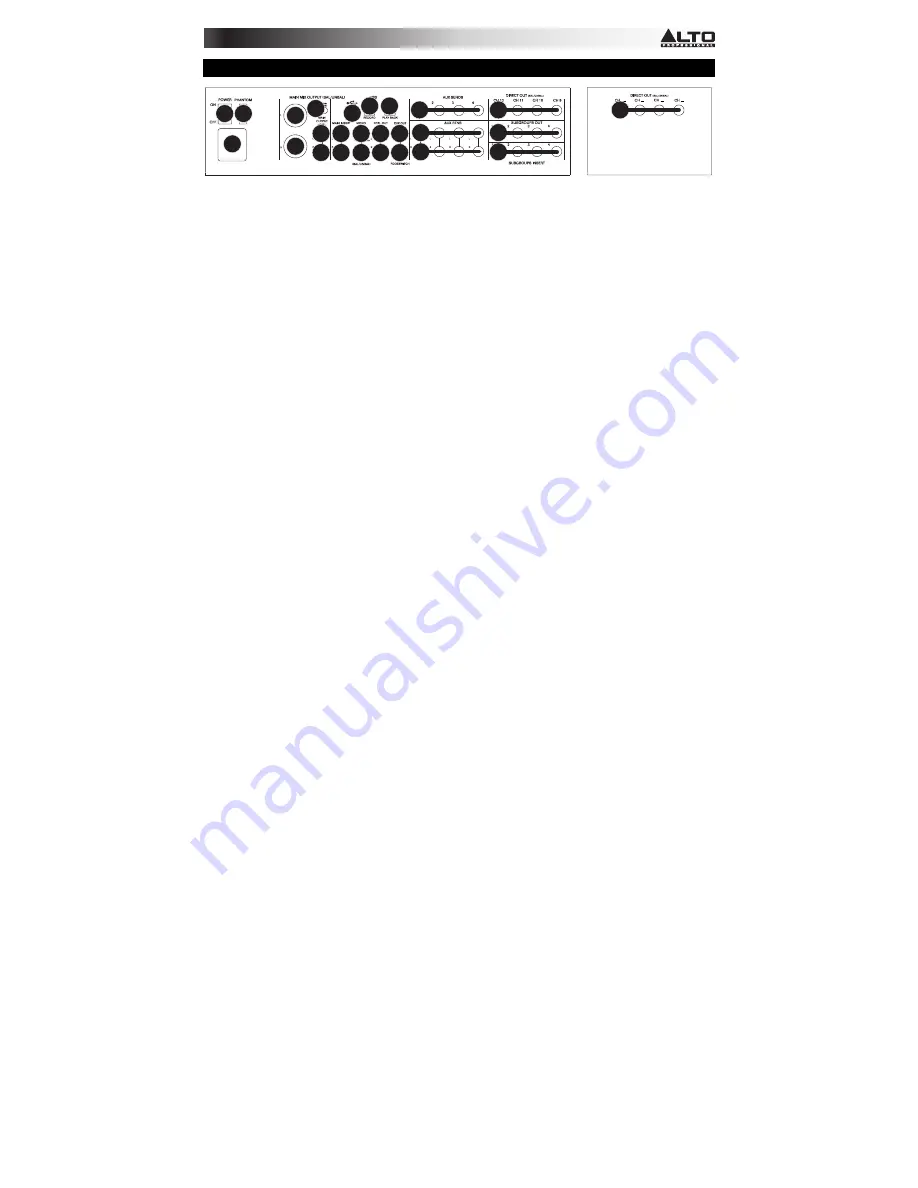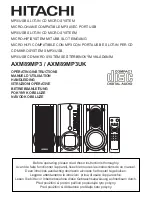
3
REAR PANEL FEATURES
1
2 3
4
4
4
5
6 7
8
9
9
10
11
12 13 14 15
16
16
18
17
17
19
6
4
1.
POWER IN –
Use the included power adapter to connect the mixer to a power outlet. While the power is switched off,
plug the power supply into the mixer first, then plug the power supply into a power outlet.
2.
POWER SWITCH –
Turns the mixer on and off. Turn on the mixer after all input devices have been connected and
before you turn on amplifiers. Turn off amplifiers before you turn off the mixer.
3.
PHANTOM POWER –
Activates/deactivates phantom power. When activated, phantom power su48V to the
XLR mic inputs. Please note that most dynamic microphones do not require phantom power, while most condenser
microphones do. Consult your microphone’s documentation to find out whether it needs phantom power.
4.
MAIN MIX OUTPUTS –
Use standard 1/4" cables to connect these outputs to the house speaker or amplifier system.
The level of these outputs is controlled by the MAIN MIX FADER.
5.
MAIN OUTPUT LEVEL –
Use this button to match the appropriate input level of a device connected to the MAIN MIX
OUTPUTS. When the button is depressed, the main mix will be reduced by 30 dB. When the button is raised, the main
mix will be boosted by 4 dB.
6.
MAIN INSERT –
Use standard 1/4" TRS cables to connect these jacks to external processors (such as compressors,
limiters, external EQ units, etc.). The audio sent out of these jacks is taken after the EQ. The audio is returned to these
jacks before the MAIN MIX FADER.
7.
MONO OUTPUT VOLUME –
Controls the level of the MONO OUTPUT.
8.
MONO OUTPUT –
This output is a summed mono version of the audio sent out of the MAIN MIX OUTPUTS. Use a
standard 1/4" TS cable to connect this jack to an external device (such as a monitor, recording device, etc.).
9.
CTRL OUTS –
Use standard 1/4" cables to connect these outputs to your monitor or amplifier system. The level of
these outputs is controlled by the CTRL ROOM VOLUME knob.
10.
DFX OUT –
This output sends out audio from the mixer's effects processor. Use a standard 1/4" TS cable to connect
this jack to an external device (such as a monitor, recording device, etc.). Adjust the level of the audio with the
EFFECTS OUT knob.
11.
FOOTSWITCH –
When a latching-style footswitch is connected to this jack with a 1/4" TRS cable, it can be used to
mute/unmute the mixer's effects processor.
12.
USB PORT –
Use a standard USB cable to connect the mixer to a computer. This port can send or receive different
kinds of audio over the USB connection, depending on the position of the USB RECORD and USB PLAYBACK
switches.
13.
USB RECORD –
When a computer is connected to the mixer's USB PORT, you can send audio from the mixer to the
computer for recording. Set this switch to "SUB1/2" to record the audio sent out of SUBGROUPS OUT 1 and 2. Set it to
"MAIN MIX" to send the main mix to the computer.
14.
USB PLAYBACK –
When a computer is connected to the mixer's USB PORT, you can send audio from the computer to
the mixer. Set this switch to "CH23/24" to send it to Channels 23/24. (Make sure the INPUT SELECTOR for Channel
23/24 is set to "USB.") Set the switch to "MAIN MIX" to send it directly to the main mix.
15.
AUX SEND ** –
Use 1/4" TRS cables to connect these outputs to the inputs of an external amplifier or active monitor.
You can adjust these levels with the AUX SENDS VOLUME knobs to create a custom monitor mix for onstage
musicians.
16.
AUX RTN (RETURN) ** –
Connect the outputs of an external device to these inputs with 1/4" mono cables. This is
usually used for outboard effects devices but can also be used like an extra input channel for synthesizers, drum
machines, etc. If your source is mono, plug it into the left jack and it will be heard on both the left and right sides.
17.
DIRECT OUT –
Use standard 1/4" TS cables to connect any of these outputs to an external device for recording,
monitoring, etc. each individual channel.
18.
SUBGROUPS OUT –
Use standard 1/4" TS cables to connect any of these outputs to an external device for recording,
monitoring, etc. each individual subgroup.
19.
SUBGROUPS INSERT –
Use standard 1/4" TRS cables to connect these jacks to external processors such as
compressors, limiters, external EQ units, etc. The audio sent out of these jacks will be the subgroup stereo signal. The
audio is returned to these jacks before the subgroups faders.

























